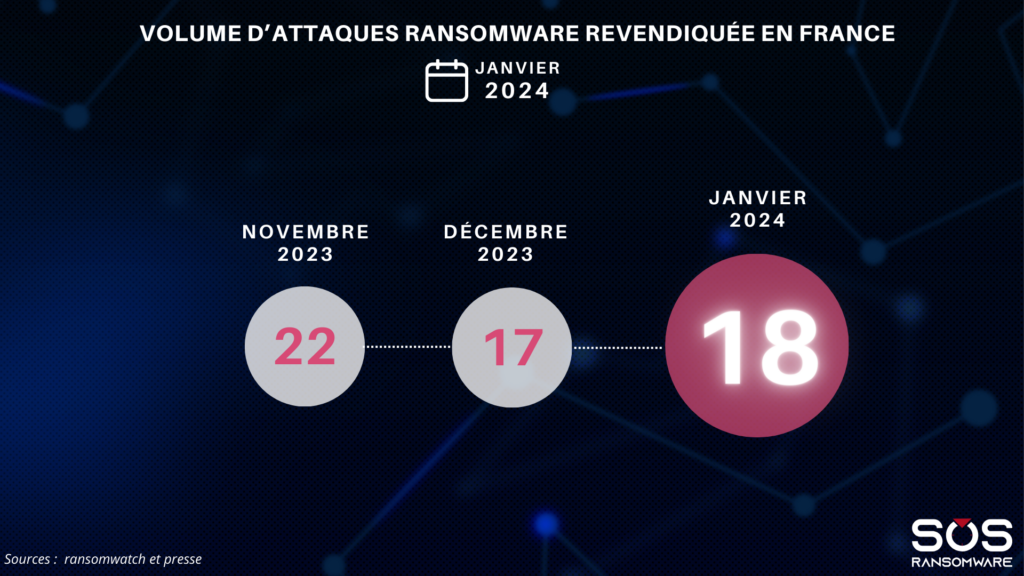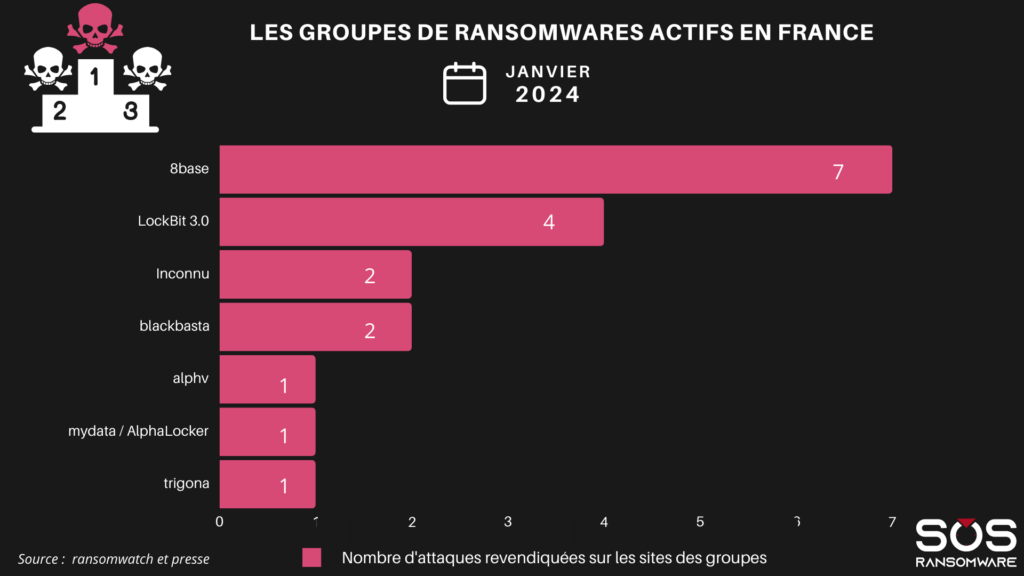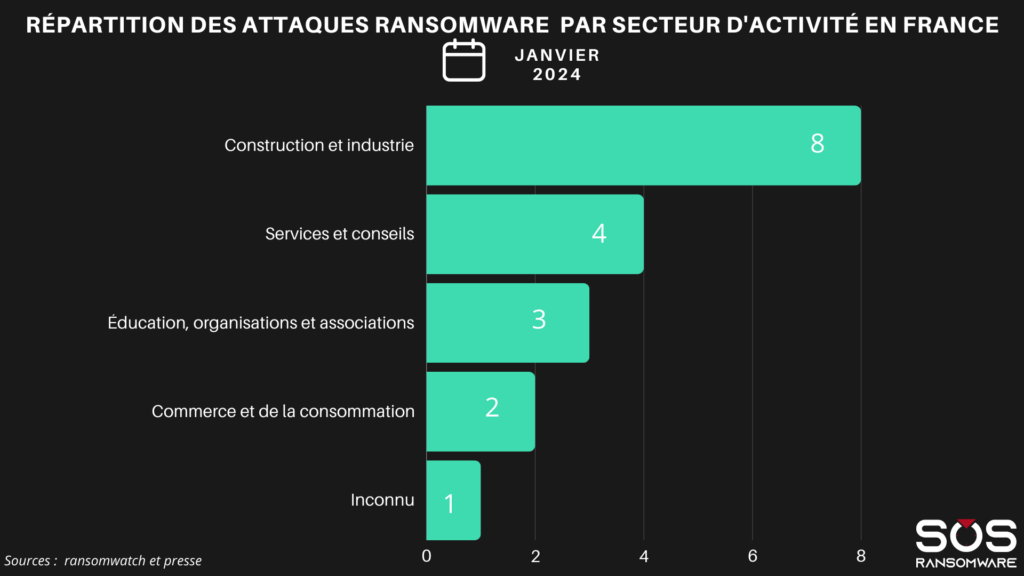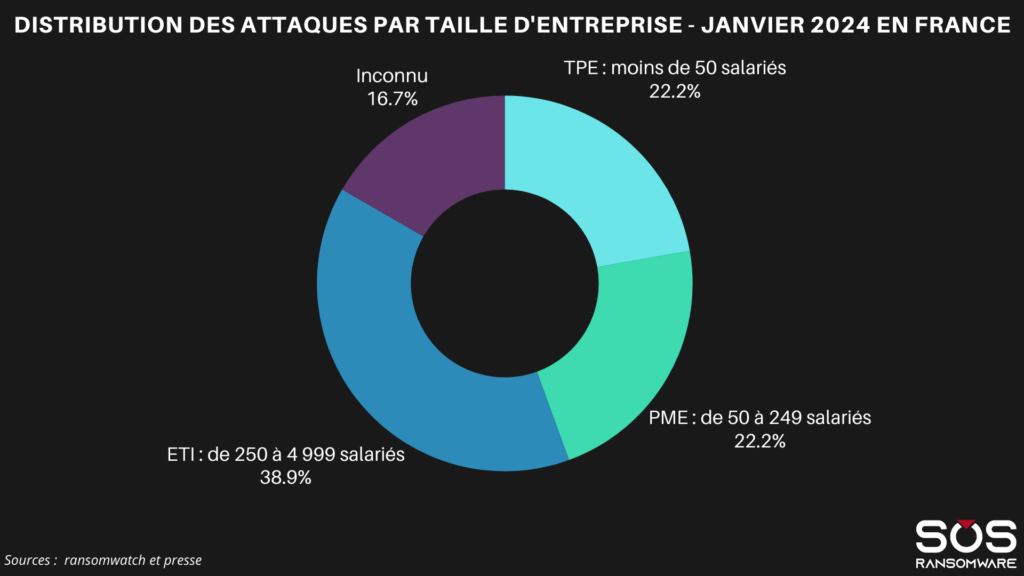On the cyberthreat front, the year 2024 begins for France with a series of ransomware attacks that are causing great concern. This analysis of recent data sheds light on the current trend.
Against the backdrop of the Olympic Games, when our country is under media fire, let’s find out the figures for ransomware attacks claimed in France, which ransomware groups dominate, or which business sectors are most affected.
Based on these January 2024 ransomware statistics, we also examine the impact of company size on the frequency of attacks.
Table des matières
ToggleRansomware attacks still going strong in 2024

The volume of ransomware attacks in France shows stability in recent months, with data reporting 22 attacks in November 2023, dropping slightly to 17 in December, and rising again to 18 in January 2024. Despite slight variations, the number of incidents remains globally constant. This consistency indicates that ransomware threats still weigh heavily on the French cyber landscape, requiring organizations to be vigilant and implement sustained security measures.
8base tops the list of ransomware attacks claimed in January 2024 in France

In January 2024, the 8base ransomware group was very active on the French cyberattack scene. It claimed 7 attacks, making it the most active group in this field. LockBit 3.0 came second with 4 attacks.
Unidentified actors also represent a source of threats, with 2 attacks reported. In addition, the Blackbasta, ALPHV/Blackcat, Mydata/AlphaLocker and Trigona groups each claimed one attack. This demonstrates the continuing and diverse presence of ransomware threats in France.
Threat mapping: French regions most affected by ransomware in January 2024

Not all regions of France are equal when it comes to cyber attacks, and the start of 2024 proves this once again. Recent data highlights which regions have been hardest hit by ransomware attacks. One region stands out: Île-de-France suffered more than 5 attacks, demonstrating that certain areas are more vulnerable. This is also the case for the regions of : Bretagne, Hauts-de-France, Pays de la Loire and Grand Est. Other regions seem less affected, with fewer than 2 incidents reported. This regional analysis is important for authorities and companies in allocating their cybersecurity resources.
Business sectors most targeted by ransomware in January 2024

The breakdown of ransomware attacks in France in January 2024 shows a concentration in certain business sectors. The construction and industry sector stands out with the highest number of claimed attacks. Indeed, this sector accounts for 8 incidents. It is followed by the services and consulting sector, which was the target of 4 attacks. The education sector, as well as organizations and associations, were also impacted, with 3 attacks each. Less affected, commerce and consumer goods were confronted with 2 attacks. These statistics show that some sectors are more affected than others. These sectors need to redouble their vigilance.
Does company size have an impact on the number of ransomware attacks?

This analysis reveals a diverse landscape depending on the size of the companies affected. Mid-sized companies (ETI), with between 250 and 4,999 employees were the most affected, suffering 38.9% of attacks.
Very small enterprises (VSEs), with fewer than 50 employees, and small and medium-sized enterprises (SMEs), with 50 to 249 employees, share a similar exposure to attacks. Each accounts for 22.2% of incidents. This analysis shows that the ransomware risk is everywhere, regardless of company size. It is therefore important to implement appropriate cybersecurity strategies for all structures.
Conclusion from January 2024 ransomware statistics
The January 2024 statistics confirm that ransomware remains a widespread threat in France, indiscriminately affecting businesses of all sizes and in multiple sectors. The constancy of attacks underlines the need for proactive cybersecurity tailored to the specific reality of each entity. In the face of this persistent threat, the focus must be on scalable defense strategies and close industry collaboration to minimize future risks and impacts.
Sources: Ransomwatch and the press
